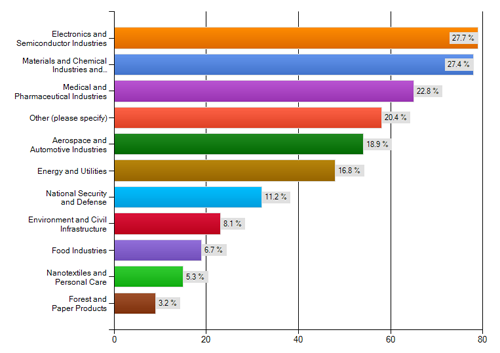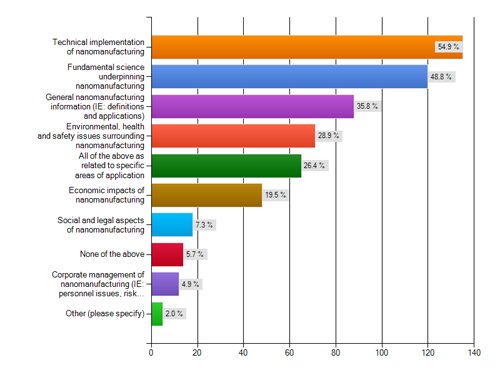During April and May, the NNN conducted a "Nanomanufacturing Information Survey" among nanotechnology professionals in an effort to understand how people inform themselves about advances in nanomanufacturing and to determine what kinds of information content and formats are most valued. In doing so, the survey provides a snapshot of the current landscape of the nanomanufacturing community.
Community
The majority of survey respondents (59.3%) indicate that they work in industry, as opposed to academia (15.8%) or government (10.5%), consulting (8.1%), or not-for-profit organizations (3.5%). Of those that work in industry, almost a third (30.2%) work in the semiconductor and electronics industries. This is consistent with overall respondents, who report working in the electronics and semiconductor industries (27.7%), materials and chemical industries (27.4%), and medical and pharmaceutical industries (22.8%) most commonly (See Chart 1).

In reporting on specific nanomanufacturing activities that are performed, a strong percentage of respondents (39.4%) indicate “none.” At the same time, respondents who do report engaging in nanomanufacturing–related activities describe a wide range of both general tasks—including research, assessment, quality control, program management, data collection, facilitation, and regulation—and technical, application-oriented tasks—CNT electronics nanofabrication, coatings development, electroplating, drug delivery, nanomaterials characterization, nanocomposite, nanopowder, and nanofiber production, nanolithography, systems design, sensor manufacturing, and the like.
The range of application areas and activities reported in this survey underscores the notion that nanomanufacturing is truly a bridge between discovery and implementation, a crossroads of research and development that reaches across all areas of application and encompasses supplementary functions such as regulation and informatics. Although the percentage of total collected responses against total distribution is too small to offer statistically-significant observations, it helps to provide a snapshot of current range of application areas active in nanomanufacturing, while also indicating to us that nanomanufacturing is still a nascent area of expertise, one that will develop as nanotechnologies mature and make their way to the marketplace with increasing frequency.
Providing critical information to the growing community of professionals who are and will become involved in the nanomanufacturing value chain is a primary objective of the National Nanomanufacturing Network and InterNano. The question remains: what kinds of information, in terms of content and format, are of most value to this community?
Content
In general, the majority of respondents value information on the technical implementation (54.9%) and fundamental science behind nanomanufacturing (48.8%) over other types of nanomanufacturing-related content, such as information on corporate management or the social and legal aspects of nanomanufacturing (See Chart 2).

Interestingly, these two categories were followed by an interest in general nanomanufacturing content (IE: definitions and areas of application) (35.8%) even over environmental health and safety issues (28.9%) or economic impacts of nanomanufacturing (19.5%). These top three categories could imply that there is a split among professionals, between those who are actively trying to integrate nanomanufacturing into their practice and those who are trying to identify if and where they belong in the nanomanufacturing value chain.
Over sixty percent of respondents who selected technical implementation as their most valued type of content in general identified advanced process methodologies as their most valued content with regard to nanomanufacturing practice (61.5%). After process methodologies, information about materials and materials vendors (56.3%) and product design and integration trends (48.1%) were the most valued practical content. Strong interest was also reported for information about equipment and equipment vendors (44.4%) and market analyses (34.1%), both of which top an interest in occupational health and safety guidelines (20.0%). This distribution is consistent with overall responses for each category.
Following this categorical assessment of nanomanufacturing content, we also posed two open-ended questions that were intended to give people some latitude in describing high-value nanomanufacturing content. When asked what kind of nanomanufacturing information is most difficult to find, forty-nine percent of respondents identified content that falls into four major areas:
- Application information: processes and ‘secret recipes,’ costs, state-of-the-art, integration issues
- Company information: examples of products, vendors, devices, market trends
- EHS: hazards, life cycle management, risk assessment, MSDS equivalents
- General/big picture: how nanotechnology is changing manufacturing; a better sense of who is addressing this area
Several responses to this question also addressed issues of quality, indicating concern over the reliability, accuracy, practicality, and realism in the information about nanomanufacturing that is currently available.
When asked to identify an essential part of nanomanufacturing, fifty-one percent of respondents offered thoughts that range from the general (infrastructure, education, “thinking outside the box”) to the specific (lithography, rapid fabrication of <100nm features, maintaining stable particle sizes). Overall, the most consistently cited components of nanomanufacturing were concepts surrounding reproducibility, scalability, precision, and quality control. These were followed by concepts surrounding materials property information, characterization, and metrology. Cost was also well represented in the responses.
The range of interest or perceived value of certain kinds of content over others is not a surprise given the demographics of survey respondents. The fact that environmental health and safety information fell toward the low end of interest while implementation and materials information were of greater interest may indicate that, at this stage, the work being done is centered on finding ways to integrate nanomaterials and advanced processes into existing products and manufacturing infrastructure.
Format
Excluding the fact that the majority of respondents report using a search engine to find the information that they need—Google being, until recently, the most visited site on the web—most respondents access their nanomanufacturing information through scholarly journals (59.3%) and trade publications (52.8%). Further, respondents report that these resources do meet their needs—71.9% for journals and 45.5% for trade publications. Society and governmental websites were the least commonly reported sources of nanomanufacturing information, at 34.2% and 30.7% respectively, with conference proceedings and government reports bringing up the rear for meeting respondents’ information needs (32.0% and 17.3%).
Most concerns about the information that is available through these resources center on questions of accuracy. Is nanomanufacturing information accurate? Biased? Up-to-date? Proprietary? Can it be corroborated? Is it an advertisement? Additional concerns describe an overall lack of relevant information or a lack of time to filter all of the information that is available. Interestingly, some respondents noted that the focus of much of information about nanomanufacturing is too academic to be useful in a practical way. At the same time, there is a demonstrated reliance upon academic journals as a source of nanomanufacturing information.
The survey closed with a question on social networking tools used for professional purposes. Forty-five percent of respondents report that they do not use any social networking tools in this way, while forty-two percent report using LinkedIn.
In Summary
The Nanomanufacturing Information Survey was an effort to understand how people inform themselves about advances in nanomanufacturing and to determine what kinds of information content and formats are most valued. Findings from this survey indicate that nanomanufacturing professionals, largely from industry, seek practical, reliable, and technical information on the implementation or integration of nanomanufacturing processes. Ongoing research into the fundamental science of nanomaterials properties and behaviors will contribute to sought after studies on reproducibility and scale-up of advanced processes. Beyond technical implementation, commercialization and cost analyses were identified as being critical pieces of information that are currently difficult to find or to filter out from available information.
In addition, an undercurrent of skepticism was demonstrated throughout the responses to questions on nanomanufacturing content and resources. Respondents indicate a strong distrust of much information that is available, frequently aluding to hyperbole and marketing as factors that obscure honest assessment of technologies. This may result in the demonstrated reliance on scholarly material that may not, however, address the need for more implementation-oriented information for use in the manufacturing setting. Perhaps, as nanomanufacturing matures, the profile of trusted information will begin to change.
The National Nanomanufacturing Network would like to thank everyone who participated in the survey and R&D Magazine for helping us to distribute it widely.
This work is licensed under a Creative Commons Attribution-NonCommercial 3.0 Unported.
